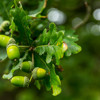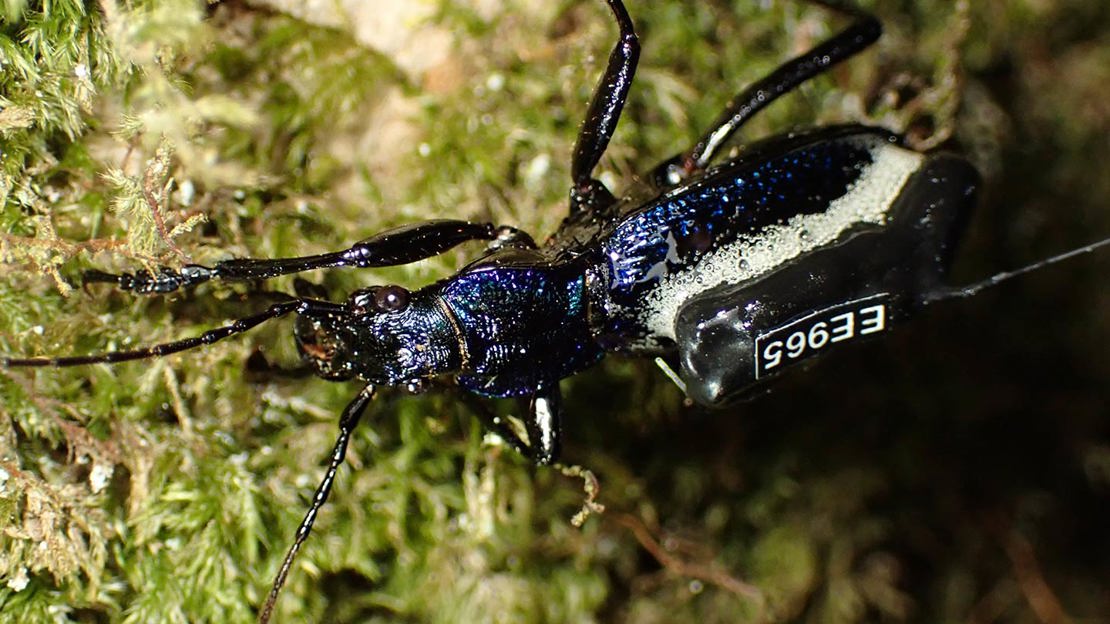New study reveals the UK’s rarest rainforest beetles are multi-day adventurers

The UK's leading woodland conservation charity
A new study delving into the lives of one of the UK’s rarest beetles shows them to be athletes and adventurers – travelling the scaled-up equivalent of several kilometres a night in search of food and mates.
Confined mostly to temperate rainforest fragments in South West England, the blue ground beetle is an elusive animal about which little is known.
However, working alongside the Woodland Trust – which owns several rainforests across the South West – scientists have been investigating how and where they thrive.
This could provide an invaluable insight into how the Trust and others could protect and restore these very rare habitats – which are more threatened than tropical rainforests – and make them more resilient to threats such as climate change. The news comes on the eve of World Rainforest Day on 22 June when the plight of these special environments is recognised.
Dr Nick Royle of the University of Exeter has been leading the study at various woods across Dartmoor, with PhD researcher Brogan Pett. He explains:
"The blue ground beetle is one of the largest and rarest species of ground beetle in the UK with a very restricted distribution, mostly on Dartmoor. However, we know relatively little about its biology, particularly how it uses the habitat it is found in and what characteristics are essential for it to thrive. Such knowledge is essential to be able to develop successful conservation practices to boost populations, which are currently highly fragmented."

The Woodland Trust, together with Natural England and Dartmoor National Parks Authority, has been supporting scientists from the University of Exeter in a Natural Environment Research Council PhD research project to track how these beetles move about their forested habitats in Dartmoor National Park, using a unique kind of tracker – a 'beetle backpack!'
The team delicately placed radio trackers on 36 of the insects – rather like mini backpacks – to record their daily movements. They found that some beetles were faster and more adventurous foragers than others, with some venturing out for multiple days before returning to their refugia (base).
PhD researcher Brogan Pett said:
"Individuals varied considerably in how active they were and how much they moved around the forest. One male whose tag number happened to be R9 turned out to be a real athlete, just like his namesake, Ronaldo. He travelled large distances within the forest each night, which is the scaled-up equivalent of several kilometres.
"The beetles are only active for a few months a year during warm, humid evenings in late spring and early summer to feast on slugs and other prey and to search for mates, so they have a limited time to get things done. Our radio-tracking revealed that they also prefer to stay away from the outside border of their woodland habitat, with individuals resting up during the day in mossy logs of decaying deadwood or in cracks in trees in shady parts of the forest."
One characteristic shared by all the beetles was a preference for old growth temperate rainforest, with plenty of decaying deadwood and an abundance of available prey.
Sam Manning, Woodland Trust site manager of the Trust-owned Bovey Valley Woods where some of the study has been carried out, said:
"The data from the project will help inform vital decisions about how we manage our precious rainforests. Blue ground beetles are an important indicator of a healthy rainforest here in the South West so we can see exactly what it is they need to thrive and repopulate. The research has already shown that blue ground beetles prefer occupying areas with old growth temperate rainforest characteristics, with high availability of decayed deadwood on the ground and forest canopy cover. It will help us to create a resilient landscape and to establish the scale of woodland habitat restoration and the new connections needed to help build that resilience."
Otherwise known as Atlantic woodland, temperate rainforest is found in areas subject to the influence of the sea (places with 'high oceanicity'). These places have high rainfall and humidity and a low annual variation in temperature. In the UK, they lie to the west coast of the country but are very rare.
This unique habitat of ancient oak, birch, ash, pine and hazel woodland is made even more diverse by open glades, boulders, crags, ravines and river gorges.
The Woodland Trust is working with various partners in the South West, Scotland and Wales to form multi-partner alliances to help protect these environments for the future.
During the build up to the general election it is calling for the new Government to develop a Trees Action Plan for England, which sets out, among other things, a plan to restore our native trees and woods to good ecological condition.
A full analysis of the beetle findings will be published in the autumn. Read more about rainforests.
Notes to editors
About the Woodland Trust
The Woodland Trust was established in 1972 and is now the UK’s largest woodland conservation charity, with more than 500,000 members and supporters.
With a vision of a world where woods and trees thrive for people and nature, today the Trust owns and cares for more than 1,000 woodland sites, covering around 33,000 hectares.
The Woodland Trust has three key aims:
- protecting the UK’s rare, unique and irreplaceable ancient woodland
- restoring damaged ancient woodland, nurturing precious pieces of our natural heritage back to life
- establishing new native trees and woods to create healthy, resilient landscapes for people and wildlife.
Access to all Woodland Trust woods is free so everyone can experience the physical and mental benefits of trees.

